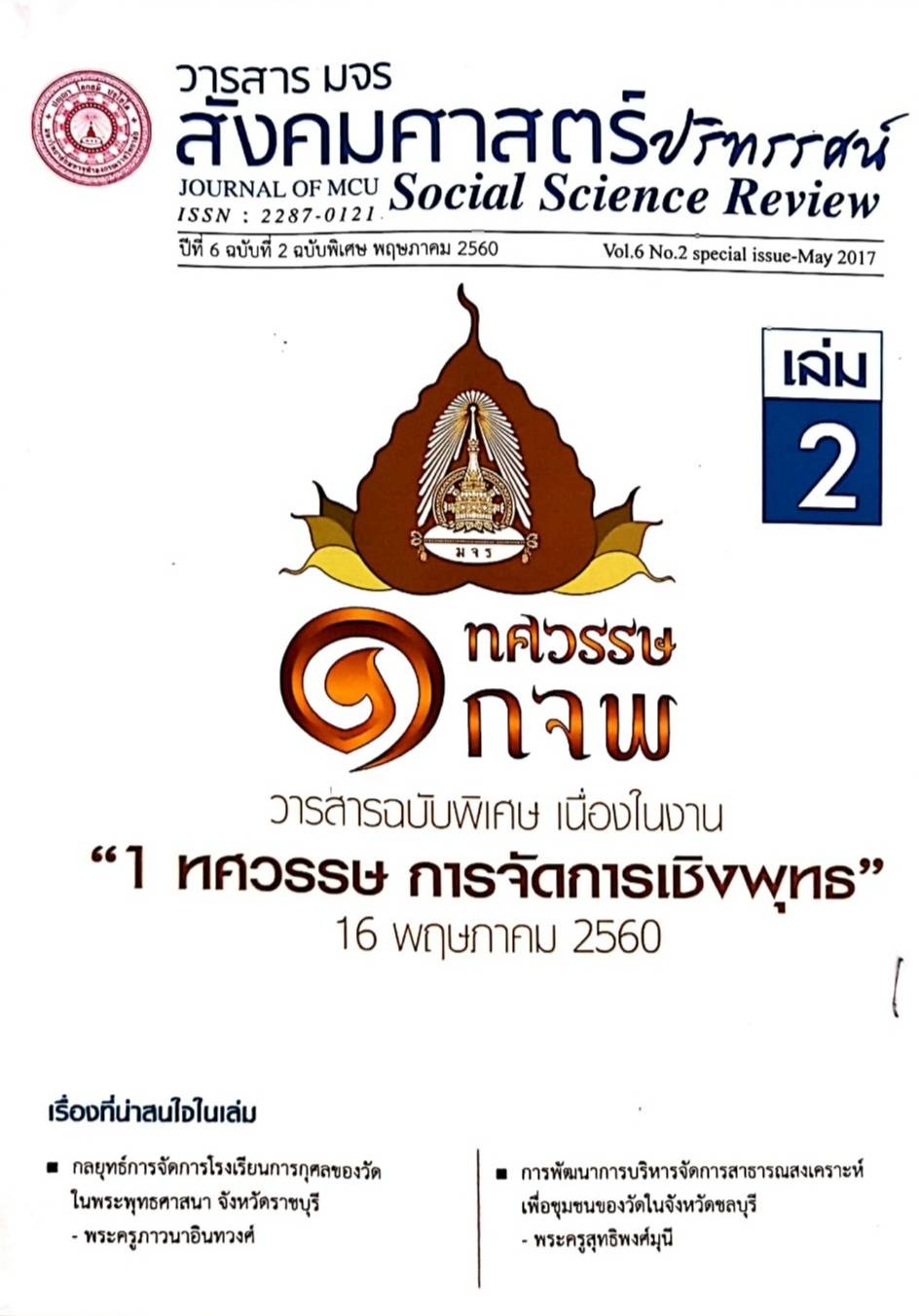การวิเคราะห์ความเชื่อและการบูชาเกี่ยวกับรอยพระพุทธบาทของชาวพุทธล้านนา
คำสำคัญ:
รอยพระพุทธบาท; ความเชื่อและการบูชา; อานิสงส์การบูชาพระพุทธบาทบทคัดย่อ
บทความ เรื่อง “การวิเคราะห์ความเชื่อและการบูชาเกี่ยวกับรอยพระพุทธบาทของชาวพุทธล้านนา” มีวัตถุประสงค์ 3 ประการ คือ 1) เพื่อศึกษาความเชื่อเกี่ยวกับรอยพระพุทธบาทในพระพุทธศาสนา 2) เพื่อศึกษาการบูชารอยพระพุทธบาทที่ปรากฏในพระพุทธศาสนา และ3) เพื่อศึกษาวิเคราะห์ความเชื่อเกี่ยวกับการบูชารอยพระพุทธบาทของชาวพุทธในล้านนา วิธีการวิจัยเป็นการวิจัยเชิงคุณภาพและการสัมภาษณ์ประกอบ ผลการวิจัยพบว่า ความเชื่อเกี่ยวกับรอยพระพุทธบาทในพระพุทธศาสนานั้น มีความเชื่อเป็นสองกลุ่มคือ กลุ่มหนึ่งเชื่อว่า รอยพระพุทธบาทนั้น มีทั้งรอยพระพุทธบาทที่พระพุทธเจ้าเสด็จมาประทับไว้ด้วย พระองค์เอง และมีทั้งรอยพระพุทธบาทที่มนุษย์สร้างขึ้น อีกกลุ่มหนึ่งเชื่อว่าเป็นสิ่งที่มนุษย์สร้างขึ้น ส่วนความเชื่อเกี่ยวกับการบูชารอยพระพุทธบาทในพระพุทธศาสนานั้นสามารถแบ่งเป็น 2 กลุ่มเช่นเดียวกัน คือ กลุ่มหนึ่งเชื่อว่าผู้ที่สักการะกราบไหว้บูชารอยพระพุทธบาท เมื่อเสียชีวิตไป แล้ว จะไม่ตกไปสู่อบายภูมิ อีกกลุ่มหนึ่งเชื่อว่าการที่จะตกไปอยู่อบายภูมิหรือสุคติภูมินั้น ขึ้นอยู่กับ วาระจิตสุดท้ายขณะเสียชีวิต ถ้าจิตยึดเหนี่ยวอยู่กับสิ่งที่เป็นกุศล เมื่อจิตดับมีโอกาสไปสู่สุคติภูมิ ดังนั้น ผู้ที่สักการะกราบไหว้บูชารอยพระพุทธบาทอยู่เสมอ เมื่อใกล้เสียชีวิตอาจทาให้จิตระลึกถึง สิ่งที่เป็นกุศลจึงไม่ตกไปสู่อบายภูมิ แต่ถ้าจิตยึดเหนี่ยวอยู่กับสิ่งที่เป็นอกุศลก็มีโอกาสไปสู่อบายภูมิ ได้ สำหรับความเชื่อเกี่ยวกับการบูชารอยพระพุทธบาทของชาวพุทธล้านนานั้นมีความเชื่อ แบ่งเป็นสองกลุ่มสอดคล้องกับข้างต้น แต่การบูชารอยพระพุทธบาทนั้นชาวพุทธล้านนาเชื่อว่า ต้องคำนึงถึงความสะอาดทั้งร่างกายและจิตใจ กล่าวคือชาระร่างกายให้สะอาดและรักษาศีล 5 หรือศีล 8 ให้บริสุทธิ์ก่อนบูชารอยพระพุทธบาท นอกจากนี้ต้องถอดหมวก ถอดรองเท้า สุภาพสตรีห้ามเข้าในที่ต้องห้าม การบูชาโดยปกติจะบูชาด้วยดอกไม้ธูปเทียนและปิดทอง แต่การบูชาประจำปีนั้น จะใช้น้ำขมิ้นส้มป่อย บางแห่งจะใช้น้าจากบ่อน้ำศักดิ์สิทธิ์ หรือน้าสรงพระราชทานในการสรงน้ำพระพุทธบาทประจาปีสำหรับผู้เป็นประธานในพิธี ประชาชนทั่วไปใช้น้าขมิ้นส้มป่อยธรรมดา ไม่คายชานหมาก ขากเสลด ถ่มน้าลาย บริเวณรอยพระพุทธบาท พึงให้ความเคารพยาเกรงด้วยกาย วาจาใจ ชาวพุทธล้านนาใช้น้าส้มป่อยในการสรงน้ารอยพระพุทธบาทเพราะชาวล้านนาเชื่อว่าส้มป่อยเป็นพืชศักดิ์สิทธิ์ที่ขจัดสิ่งชั่วร้ายออกไปจากชีวิต เพราะคาว่า “ป่อย” หมายถึง ปลดปล่อยสิ่งจัญไร อัปมงคลออกไป สาหรับความเชื่อเกี่ยวกับอานิสงส์ของการบูชารอยพระพุทธบาทในช่วงเวลาที่มีชีวิตอยู่ ชาวพุทธล้านนาเชื่อว่าจะทาให้ตนเองและครอบครัวอยู่เย็นเป็นสุข ปราศจากโรคภัย แคล้วคลาดจากอันตราย มีความก้าวหน้าในหน้าที่การงาน และฝนตกต้องตามฤดูกาล นับว่าเป็นความเชื่ออันทรงคุณค่าที่บรรพบุรุษของไทยล้านนาได้ปลูกฝังและถ่ายทอดมายังอนุชนรุ่นหลังอย่างมีนัยสำคัญ
เอกสารอ้างอิง
บุญเลิศ เสนานนท์. (2536). ตำนานพระพุทธบาทและคัมภีร์พุทฺธปาทลกฺขณ. กรุงเทพฯ: บริษัท ศรีอนันต์การพิมพ์ จำกัด.
มหาจุฬาลงกรณราชวิทยาลัย. (2539). พระไตรปิฎกภาษาไทย ฉบับมหาจุฬาลงกรณราชวิทยาลัย.กรุงเทพฯ: โรงพิมพ์มหาจุฬาลงกรณราชวิทยาลัย.
หลวงบริบาลบุรีภัณฑ์. (2504). พระพุทธบาทจังหวัดสระบุรี. พิมพ์ครั้งที่ 7. พระนคร: โรงพิมพ์พระจันทร์.
Virginia McKeen Di Crocco. แปลโดย สมหวัง แก้วสุฟอง. (2555). รอยพระบาทพระพุทธเจ้า 5 พระองค์ ใน ภัทรกัปนี้ ตามกรอบคิดแบบสิงหล – สยาม. นครปฐม: หมีดีไซน์.
ดาวน์โหลด
เผยแพร่แล้ว
รูปแบบการอ้างอิง
ฉบับ
ประเภทบทความ
สัญญาอนุญาต
ลิขสิทธิ์ (c) 2020 วารสาร มจร สังคมศาสตร์ปริทรรศน์

อนุญาตภายใต้เงื่อนไข Creative Commons Attribution-NonCommercial-NoDerivatives 4.0 International License.
เพื่อให้เป็นไปตามกฎหมายลิขสิทธิ์ ผู้นิพนธ์ทุกท่านต้องลงลายมือชื่อในแบบฟอร์มใบมอบลิขสิทธิ์บทความให้แก่วารสารฯ พร้อมกับบทความต้นฉบับที่ได้แก้ไขครั้งสุดท้าย นอกจากนี้ ผู้นิพนธ์ทุกท่านต้องยืนยันว่าบทความต้นฉบับที่ส่งมาตีพิมพ์นั้น ได้ส่งมาตีพิมพ์เฉพาะในวารสาร มจร สังคมศาสตร์ปริทรรศน์ เพียงแห่งเดียวเท่านั้น หากมีการใช้ภาพหรือตารางหรือเนื้อหาอื่นๆ ของผู้นิพนธ์อื่นที่ปรากฏในสิ่งตีพิมพ์อื่นมาแล้ว ผู้นิพนธ์ต้องขออนุญาตเจ้าของลิขสิทธิ์ก่อน พร้อมทั้งแสดงหนังสือที่ได้รับการยินยอมต่อบรรณาธิการ ก่อนที่บทความจะได้รับการตีพิมพ์ หากไม่เป็นไปตามข้อกำหนดเบื้องต้น ทางวารสารจะถอดบทความของท่านออกโดยไม่มีข้อยกเว้นใดๆ ทั้งสิ้น





